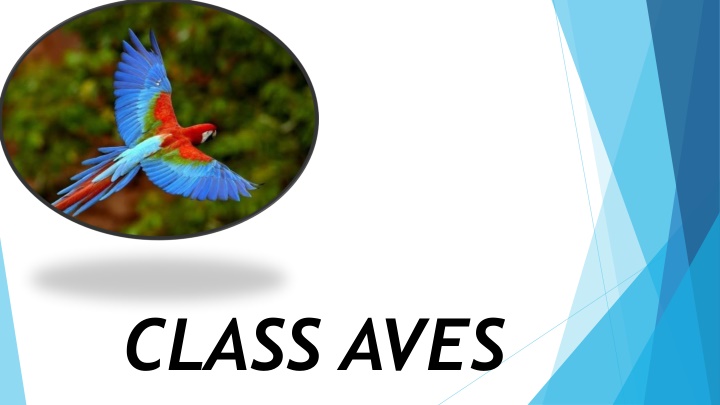Classification of Class Aves and its Sub-Classes
Class Aves is divided into two sub-classes based on characteristics like teeth, claws, and bone structure. The sub-classes are Archaeornithes and Neornithes, each with distinct features and orders. Archaeornithes include the extinct order Archaeopterigiforms, exhibiting reptilian and avian traits. Neornithes, on the other hand, lack teeth and claws, with formed carpometacarpus and tarsometacarpus. Further division in Neornithes includes 3 super-orders based on wing nature and sternum structure. The text elaborates on the characteristics of each sub-class and their associated orders.
Download Presentation

Please find below an Image/Link to download the presentation.
The content on the website is provided AS IS for your information and personal use only. It may not be sold, licensed, or shared on other websites without obtaining consent from the author.If you encounter any issues during the download, it is possible that the publisher has removed the file from their server.
You are allowed to download the files provided on this website for personal or commercial use, subject to the condition that they are used lawfully. All files are the property of their respective owners.
The content on the website is provided AS IS for your information and personal use only. It may not be sold, licensed, or shared on other websites without obtaining consent from the author.
E N D
Presentation Transcript
CLASSIFICATION On the basis of teeth, claws on fingers, tail vertebrae and hand bones, class Aves is divided into two sub-classes
TWO SUB-CLASSES OF CLASS AVES Sub-class Archaeornithes Sub-class Neornithes
SUB-CLASS ARCHAEORNITHES (Gk. Archae=extinct; Ornithes=birds) 1. Jaws are with acrodont teeth. 2. Claws are present on fingers. 3. Tail (caudal) vertebrae are free so no pygostyle is formed. 4. Carpals and metacarpals are free form each other so there is no carpometacarpus.
Sub-class Archaeornithes includes single order Archaeopterigiforms (archaeo=extinct;pteron=wing).This order is charactrisized by: jaw bones with Homodont theeth as in Reptiles. 1. 2. Mouth bounded by beak as in birds. 3. Cranium is rounded as in birds. 4. Presence of claws on fingers (as in reptiles)as well as toes. 5. Sternum is keelless. 6. There is no covered carpometacarpus in forelimb while hind limb is with tarsometatarsus. 7. Body is covered with feathers as in birds. Owing to these characters, Huxley called the birds as glorified reptiles. e.g. Archaeopteryx(flying lizard) is a missing link between the reptiles and birds.
SUB-CLASS NEORNITHES (Gk.neo=new;ornithos=birds): It is characterized by: 1. Absence of teeth from the jaws(edentulous). 2. Fingers are without claws. 3. Carpometacarpus and tarsometacarpus are formed.
Sub-class Neornithes is divided into 3 super-orders: Palaeognathae, Impennae and Neognathae, on the basis of nature of wings ,sternum and feathers. CHARACTERS SUPER O. PALAEOGNATHAE ( palaeo =old; gnathos =jaw) SUPER O. IMPENNAE SUPER O. NEOGNATHAE (neo=new; gnathae=jaw) Nature of wings Wings are vestigial so reduced. Forelimbs are modified into paddles or flippers. Wings are well developed as flight organs. Sternum Keelless Keelless Keeled. Feathers Reduced into hair-like structures. Reduced into scale-like structures. Feathers large sized and present along definite tracts called pterylae separated by featherless tracts called apteria
A.SUPER- ORDER PALAEOGNATHAE It is also called Ratitae, includes running birds. It is divided into 3 orders: Struthioniformes, Casuariformes and Apterigiformes on the basis of number of toes. ORDER NUMBER OF TOES Only two toes (3rdand 4th) in each foot. Struthio (ostrich) Found in the deserts of Africa and Arabia. It is largest bird and its egg is also largest sized (170X135). Casuarius (cassowary)- Found in Australia and nearby islands. Apteryx (kiwi) Found in New Zealand. It is smallest flightless bird. O.Struthioniformes Three functional toes in each foot. O.Casuariformes Four functional toes in each foot. O.Apterigiformes
B. SUPER-ORDER IMPENNAE It is characterized by: Presence of a thick layer of fat beneath the skin for conservation of body heat as the members are inhabitants of extremely cold areas. All the four toes are forward directed and webbed. It includes single Order Sphaenisciformes characterized by above characters and includes Aptenodytes (Penguins).
C. SUPER ORDER-NEOGNATHAE It is divided into 21 orders, important of which are: 1. Order Ciconiiforms. It includes the wading birds and is characterized by: a) Long and pointed back to capture the prey (fish and other aquatic animals). b) Long and slender legs for wading in water bodies. e.g: Ardea Grey heron, Bubulcus Cattle egret.
2. Order Anseriforms. It includes the aquatic birds and is characterized by: a) Toes are webbed for swimming in fresh-water bodies. b) Flat beak with horny ridges called lamellae to scan food in mud. e.g: Anser- Goose, Cygnus- Swan, Anas- Duck.
3) Order Falconiformes. It includes diurnal birds of prey and is characterized by: a) Clawed digits to grasp the prey. b) Hooked beak to tear the prey. e.g: Milvus Kite, Falco Falcon, Gyps Vulture.
PRESENTATION SUBMITTED TO:- MR. MUNISH DHIMAN SUBMITTED BY:- HIMANI ( Bsc. 1ST YEAR)























